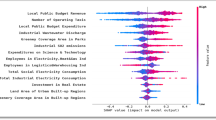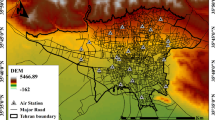Abstract
The escalation of ground-level ozone (O3) pollution presents a significant challenge to the sustainable growth of Chinese cities. This study utilizes advanced machine learning algorithms to investigate the intricate interplay between urban socioeconomic growth and O3 levels. Surpassing traditional environmental chemistry, it assesses the effectiveness of these algorithms in interpreting socioeconomic and environmental data, while elucidating urban development’s environmental impacts from a novel socioeconomic perspective. Key findings indicate that factors such as urban infrastructure, industrial activities, and demographic dynamics significantly influence O3 pollution. The study highlights the particular sensitivity of urban public transportation and population density, each exerting a unique and substantial effect on O3 levels. Additionally, the research identifies nuanced interactions among these factors, indicating a complex web of influences on urban O3 pollution. These interactions suggest that the impact of individual socioeconomic elements on O3 pollution is interdependent, being either amplified or mitigated by other factors. The study emphasizes the crucial need to integrate socioeconomic variables into urban O3 pollution strategies, advocating for policies tailored to each city’s distinct characteristics, informed by the detailed analysis provided by machine learning. This approach is essential for developing effective and nuanced urban pollution management strategies.







Similar content being viewed by others
Data availability
The datasets used and analyzed during the current study are available from the corresponding author upon reasonable request.
References
Aas, K,. Jullum, M., & Loland, A. (2021). Explaining individual predictions when features are dependent: More accurate approximations to Shapley values. Artificial Intelligence, 298, 103502.
Belle, V., & Papantonis, I. (2021). Principles and practice of explainable machine learning. Frontiers in Big Data, 4, 688969.
Ben Saad, M. (2017). The effect of economic complexity on air pollution: Another approach to the environmental curve of Kuznets. Region Et Developpement, 46, 21–41.
Borck, R., & Schrauth, P. (2021). Population density and urban air quality. Regional Science and Urban Economics, 86(24), 103596.
Borgonovo, E., & Plischke, E. (2016). Sensitivity analysis: A review of recent advances. European Journal of Operational Research, 248, 869–887.
Carbo-Bustinza, N., Belmonte, M., Jimenez, V., Montalban, P., Rivera, M., Martínez, F. G., ... & López-Gonzales, J. L. (2022). A machine learning approach to analyse ozone concentration in metropolitan area of Lima, Peru. Scientific Reports, 12(1), 22084.
Chai, T., & Draxler, R. R. (2014). Root mean square error (RMSE) or mean absolute error (MAE)? — Arguments against avoiding RMSE in the literature. Geoscientific Model Development, 7, 1247–1250.
Chameides, W. L., Li, X. S., Tang, X. Y., Zhou, X. J., Luo, C., Kiang, C. S., St John, J., Saylor, R. D., Liu, S. C., Lam, K. S., Wang, T., & Giorgi, F. (1999). Is ozone pollution affecting crop yields in China? Geophysical Research Letters, 26, 867–870.
Chang, R.P, Wang, B., Zhang, Y., & Zhao, L. (2022). Foreign direct investment and air pollution: Re-estimating the “Pollution Haven Hypothesis” in China. Sustainability, 14(21),13759.
Chen, H., & Chen, W. Y. (2019). Potential impacts of coal substitution policy on regional air pollutants and carbon emission reductions for China’s building sector during the 13th Five-Year Plan period. Energy Policy, 131, 281–294.
Chen, T. M., Gokhale, J., Shofer, S., & Kuschner, W. G. (2007). Outdoor air pollution: Ozone health effects. American Journal of the Medical Sciences, 333, 244–248.
Cheng, Y., He, L. Y., & Huang, X. F. (2021). Development of a high-performance machine learning model to predict ground ozone pollution in typical cities of China. Journal of Environmental Management, 299, 113670.
Cheng, Y., Huang, X. F., Peng, Y., Tang, M. X., Zhu, B., Xia, S. Y., & He, L. Y. (2023). A novel machine learning method for evaluating the impact of emission sources on ozone formation. Environmental Pollution, 316, 120685.
Chicco, D., Warrens, M. J., & Jurman, G. (2021). The coefficient of determination R-squared is more informative than SMAPE, MAE, MAPE, MSE and RMSE in regression analysis evaluation. Peerj Computer Science, 7, e623.
de Myttenaere, A., Golden, B., Le Grand, B., & Rossi, F. (2016). Mean Absolute Percentage Error for regression models. Neurocomputing, 192, 38–48.
Heggelund, G. M. (2021). China’s climate and energy policy: At a turning point? International Environmental Agreements-Politics Law and Economics, 21, 9–23.
Huang, J., Pan, X. C., Guo, X. B., & Li, G. X. (2018). Health impact of China’s Air Pollution Prevention and Control Action Plan: An analysis of national air quality monitoring and mortality data. Lancet Planetary Health, 2, E313–E323.
Hui, C, H., Shen, F., Tong, L., Zhang, J. R., & Liu, B. (2022). Fiscal pressure and air pollution in resource-dependent cities: Evidence from China. Frontiers in Environmental Science, 10, 908490.
Jin, Y. N., Andersson, H., & Zhang, S. Q. (2016). Air pollution control policies in China: A retrospective and prospects. International Journal of Environmental Research and Public Health, 13(12), 1219.
Lin, B. Q., & Zhou, Y. C. (2022). Understanding the institutional logic of urban environmental pollution in China: Evidence from fiscal autonomy. Process Safety and Environmental Protection, 164, 57–66.
Lu, X., Zhang, L., Chen, Y. F., Zhou, M., Zheng, B., Li, K., Liu, Y. M., Lin, J. T., Fu, T. M., & Zhang, Q. (2019). Exploring 2016–2017 surface ozone pollution over China: Source contributions and meteorological influences. Atmospheric Chemistry and Physics, 19, 8339–8361.
Luo, W. J., & Liu, Y. J. (2022). Research on the impact of fiscal decentralization on governance performance of air pollution—Empirical evidence of 30 provinces from China. Sustainability, 14(18), 11313.
Malley, C. S., Henze, D. K., Kuylenstierna, J. C., Vallack, H. W., Davila, Y., Anenberg, S. C., ... & Ashmore, M. R. (2017). Updated global estimates of respiratory mortality in adults ≥30 years of age attributable to long-term ozone exposure. Environmental Health Perspectives, 125(8), 087021.
Meinardi, S., Nissenson, P., Barletta, B., Dabdub, D., Rowland, F. S., & Blake, D. R. (2008). Influence of the public transportation system on the air quality of a major urban center. A case study: Milan. Italy. Atmospheric Environment, 42, 7915–7923.
Pagliaro, M., & Meneguzzo, F. (2019). Electric bus: A critical overview on the dawn of its widespread uptake. Advanced Sustainable Systems, 3(6), 1800151.
Pan, Q. L., Harrou, F., & Sun, Y. (2023). A comparison of machine learning methods for ozone pollution prediction. Journal of Big Data, 10(1), 63.
Pedregosa, F., Varoquaux, G., Gramfort, A., Michel, V., Thirion, B., Grisel, O., Blondel, M., Prettenhofer, P., Weiss, R., Dubourg, V., Vanderplas, J., Passos, A., Cournapeau, D., Brucher, M., Perrot, M., & Duchesnay, E. (2011). Scikit-learn: Machine learning in Python. Journal of Machine Learning Research, 12, 2825–2830.
Qian, J., Liao, H., Yang, Y., Li, K., Chen, L., & Zhu, J. (2022). Meteorological influences on daily variation and trend of summertime surface ozone over years of 2015–2020: Quantification for cities in the Yangtze River Delta. Science of the Total Environment, 834, 155107.
Que, W., Zhang, Y. B., Liu, S. B., & Yang, C. P. (2018). The spatial effect of fiscal decentralization and factor market segmentation on environmental pollution. Journal of Cleaner Production, 184, 402–413.
Ruan ZengLiang, R. Z., Qian ZhengMin, Q. Z., Guo YanFei, G. Y., Zhou Jin, Z. J., Yang Yin, Y. Y., Acharya, B. K., ... & Lin HuaLiang, L. H. (2019). Ambient fine particulate matter and ozone higher than certain thresholds associated with myopia in the elderly aged 50 years and above. Environmental Research, 177, 108581.
Sampedro, J., Waldhoff, S. T., Van de Ven, D. J., Pardo, G., Van Dingenen, R., Arto, I., ... & Sanz, M. J. (2020). Future impacts of ozone driven damages on agricultural systems. Atmospheric Environment, 231, 117538.
Shu, Y., Hu, J.N, Zhang, S.H, Schöpp, W., Tang, W., Du, J., ... & Xie, D.Y. (2022). Analysis of the air pollution reduction and climate change mitigation effects of the three-year action plan for blue skies on the “2 + 26” cities in China. Journal of Environmental Management, 317, 115455.
Sicard, P., Paoletti, E., Agathokleous, E., Araminienė, V., Proietti, C., Coulibaly, F., & De Marco, A. (2020). Ozone weekend effect in cities: Deep insights for urban air pollution control. Environmental Research, 191, 110193.
Tang, X., Gao, X., Li, C., Zhou, Q., Ren, C., & Feng, Z. (2020). Study on spatiotemporal distribution of airborne ozone pollution in subtropical region considering socioeconomic driving impacts: A case study in Guangzhou, China. Sustainable Cities and Society, 54, 101989.
Wang, T., Ding, A., Gao, J., & Wu, W. S. (2006). Strong ozone production in urban plumes from Beijing, China. Geophysical Research Letters, 33(21), L21806.
Wang, N., Lyu, X. P., Deng, X. J., Huang, X., Jiang, F., & Ding, A. J. (2019). Aggravating O3 pollution due to NOx emission control in eastern China. Science of the Total Environment, 677, 732–744.
Wang, T., Xue, L. K., Brimblecombe, P., Lam, Y. F., Li, L., & Zhang, L. (2017). Ozone pollution in China: A review of concentrations, meteorological influences, chemical precursors, and effects. Science of the Total Environment, 575, 1582–1596.
Yan, D., Zhou, M., Diao, Y., & Yang, M. (2022). Air pollution in China: Spatial patterns and spatial coupling with population and economy. Frontiers in Environmental Science, 10, 1040131.
Yang, G. F., Liu, Y. H., Li, W. L., & Zhou, Z. Y. (2023). Association analysis between socioeconomic factors and urban ozone pollution in China. Environmental Science and Pollution Research, 30, 17597–17611.
Yu, C., Kang, J., Teng, J., Long, H., & Fu, Y. (2021). Does coal-to-gas policy reduce air pollution? Evidence from a quasi-natural experiment in China. Science of the Total Environment, 773, 144645.
Zhang, X., Yan, B., Du, C., Cheng, C., & Zhao, H. (2021). Quantifying the interactive effects of meteorological, socioeconomic, and pollutant factors on summertime ozone pollution in China during the implementation of two important policies. Atmospheric Pollution Research, 12(12), 101248.
Zhang, L., Yuan, W.B, & Zhang, Z.Q. (2023). Implementation effect of air pollution policy, long-term mechanism, and industrial structure promotion—A quasi-natural experiment based on ambient air quality standards. Environmental Science and Pollution Research, 30(37), 87368–87381.
Zhang, H. L., Wang, Y. G., Hu, J. L., Ying, Q., & Hu, X. M. (2015a). Relationships between meteorological parameters and criteria air pollutants in three megacities in China. Environmental Research, 140, 242–254.
Zhang, X. Y., Trame, M. N., Lesko, L. J., & Schmidt, S. (2015b). Sobol sensitivity analysis: A tool to guide the development and evaluation of systems pharmacology models. Cpt-Pharmacometrics & Systems Pharmacology, 4, 69–79.
Zhang, Y. Y., & Gao, B. (2022). Does foreign direct investment aggravate China’s air pollution?—Based on partial differential effect decomposition. Journal of Nonlinear and Convex Analysis, 23, 2011–2020.
Zhao, N.Z, Pinault, L., Toyib, O., Vanos, J., Tjepkema, M., & Cakmak, S. (2021). Long-term ozone exposure and mortality from neurological diseases in Canada. Environment International, 157, 106817.
Funding
This research is supported by the education funding (No. SDKC202127).
Author information
Authors and Affiliations
Contributions
Kun Xiang: writing the original draft, software coding, data analyses, revising the manuscript critically for important content, and English writing. Danxi Shi: resources and revising the manuscript critically for important content. Xiangyun Xiang: writing review and editing.
Corresponding author
Ethics declarations
Competing interests
The authors declare no competing interests.
Additional information
Publisher's Note
Springer Nature remains neutral with regard to jurisdictional claims in published maps and institutional affiliations.
Supplementary Information
Below is the link to the electronic supplementary material.
Rights and permissions
Springer Nature or its licensor (e.g. a society or other partner) holds exclusive rights to this article under a publishing agreement with the author(s) or other rightsholder(s); author self-archiving of the accepted manuscript version of this article is solely governed by the terms of such publishing agreement and applicable law.
About this article
Cite this article
Xiang, K., Shi, D. & Xiang, X. Machine learning analysis of socioeconomic drivers in urban ozone pollution in Chinese cities. Environ Monit Assess 196, 314 (2024). https://doi.org/10.1007/s10661-024-12489-2
Received:
Accepted:
Published:
DOI: https://doi.org/10.1007/s10661-024-12489-2




